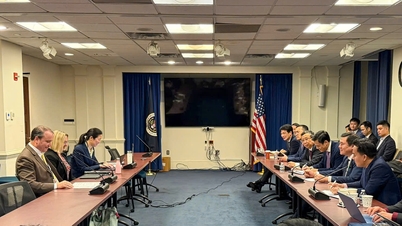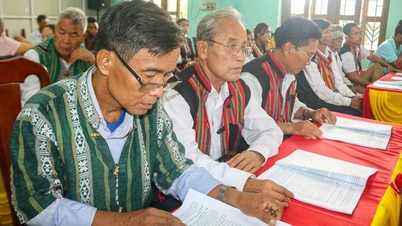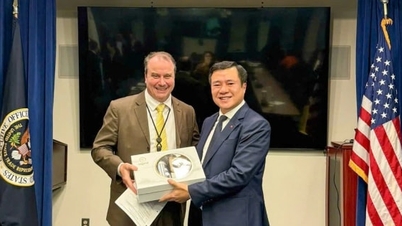
In response to some opinions that the proposal for a "special salary coefficient" has no legal basis and could disrupt the current salary system, the Ministry has clearly explained that this regulation comes from the Party's consistent policy over the past three decades: teachers' salaries must be given the highest priority in the administrative salary scale system.
From the 1996 Central Resolution 2 to Resolution 29 (2013) and most recently Resolution 71 of the Politburo , the Party has affirmed the need for special and outstanding preferential policies for teachers. The National Assembly has included this spirit in the Law on Teachers, which clearly stipulates: "Teachers' salaries are ranked highest in the administrative career salary scale system". Thus, the construction of a "special salary coefficient" is a technical measure to implement the provisions of the Law, not an exceptional mechanism.
The special coefficient does not change the salary scale of civil servants in general. Teachers' salaries from 2026 are calculated according to the formula:
Salary = Basic salary × Current salary coefficient × Specific salary coefficient
Thus, the salary scale (A0 → A3.1/A3.2) remains the same; the specific coefficient is only multiplied to ensure that the final salary of the teacher is truly "highest", and at the same time does not affect the calculation of allowances, nor does it affect the reserved difference coefficient according to the guidance of the Ministry of Home Affairs .
From the current reality, we can see the reason for the need for a specific coefficient: most teachers are receiving lower salaries than civil servants in other sectors, although the requirements for professional qualifications, qualities and professional standards are all strict. Data from the Ministry of Education and Training shows that 88% of teachers are currently ranked in the lower salary group, and only 1.17% reach the A3.1 - A3.2 salary group, while other sectors have about 10% of civil servants in the highest salary group.
Table 1: Current status of teachers' salary classification
Salary scale group | Interpretation | Proportion of civil servants in other sectors | Teacher ratio |
A3.1 – A3.2 | Top group | About 10% | 1.17% |
A2.1 – A2.2 – A1 | Middle - high group | Almost all of the staff | ~12% of teachers |
A0, B, C | Low group | Almost gone | 88% of teachers |
Preschool teachers in particular are the group that suffers the greatest disadvantage in the entire system, as they are all at the lowest level of the administrative career salary scale:
Table 2: Comparison of salary coefficients of preschool teachers and civil servants in other sectors
Title rank | Starting coefficient of preschool teachers | Starting coefficients of other industries | Difference |
Class III | 2.10 | 2.34 | 1.11 times higher |
Class II | 2.34 | 4.40 | 1.88 times higher |
Class I | 4.00 | 6.20 | 1.55 times higher |
Maximum coefficient | 6.38 | 8.00 | 1.25 times higher |
These figures show that although the policy of "highest teacher salary" was proposed in 1996, the actual salary arrangement has not yet reflected that spirit. Meanwhile, teachers are a special labor force—requiring deep professional knowledge, pedagogical skills, moral qualities, perseverance, and responsibility to create human resources for the country's future.

The application of specific coefficients is even more meaningful in the context of salary reform under Resolution 27-NQ/TW, when seniority allowances are only applied to the military, police and cryptography; teachers are no longer entitled to this type of allowance. That makes the need for a compensation mechanism, recognizing the specific characteristics of the profession, necessary and reasonable.
The new salary policy under the Law on Teachers has had an immediate effect right after being passed by the National Assembly: the benchmark scores of teacher training colleges have increased significantly, the source of teacher recruitment is more abundant, and many previously difficult subjects now have a large number of candidates. This reflects the great expectations and confidence of the teaching staff in the new salary arrangement.
The draft Decree is currently being widely consulted and the majority of opinions from ministries, branches and localities agree with the addition of specific coefficients. The Ministry of Education and Training said it will continue to complete the draft content, coordinate with the Ministry of Finance to calculate resources, submit to the Government for consideration and promulgation, ensuring that the salary policy is truly in line with the Party's policies, the provisions of the Law and meets the legitimate expectations of millions of teachers nationwide.
Source: https://baolangson.vn/he-so-luong-dac-thu-phan-anh-dung-chu-truong-luong-nha-giao-cao-nhat-5065049.html


![[Photo] Exciting contest of skillful red fruit picking and creativity from Son La coffee beans](https://vphoto.vietnam.vn/thumb/1200x675/vietnam/resource/IMAGE/2025/11/15/1763201832979_ndo_bl_3-jpg.webp)
![[Photo] Action for the Community tells stories of enduring journeys – both intimate and great, yet quiet and determined](https://vphoto.vietnam.vn/thumb/1200x675/vietnam/resource/IMAGE/2025/11/15/1763179022035_ai-dai-dieu-5828-jpg.webp)

![[Photo] General Secretary To Lam receives Governor of Kanagawa Province (Japan) Kuroiwa Yuji](https://vphoto.vietnam.vn/thumb/1200x675/vietnam/resource/IMAGE/2025/11/15/1763204231089_a1-bnd-7718-5559-jpg.webp)

![[Photo] The Government Standing Committee reviews the planning project of the Red River landscape avenue axis](https://vphoto.vietnam.vn/thumb/1200x675/vietnam/resource/IMAGE/2025/11/15/1763197032149_dsc-0163-jpg.webp)





























































































Comment (0)